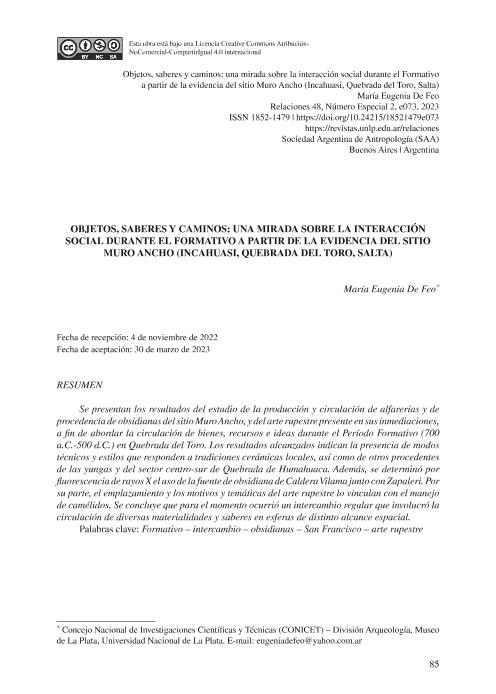Mostrar el registro sencillo del ítem
dc.contributor.author
de Feo, Maria Eugenia

dc.date.available
2024-01-16T14:06:51Z
dc.date.issued
2023-10
dc.identifier.citation
de Feo, Maria Eugenia; Objetos, saberes y caminos: una mirada sobre la interacción social durante el Formativo a partir de la evidencia del sitio Muro Ancho (Incahuasi, Quebrada del Toro, Salta); Sociedad Argentina de Antropología; Relaciones; 48; Especial 2; 10-2023; 85-106
dc.identifier.issn
0325-2221
dc.identifier.uri
http://hdl.handle.net/11336/223778
dc.description.abstract
Se presentan los resultados del estudio de la producción y circulación de alfarerías y de procedencia de obsidianas del sitio Muro Ancho, y del arte rupestre presente en sus inmediaciones, a fin de abordar la circulación de bienes, recursos e ideas durante el Período Formativo (700 a.C. – 400 d.C.) en Quebrada del Toro. Los resultados alcanzados indican la presencia de modos técnicos y estilos que responden a tradiciones cerámicas locales, así como de otros procedentes de las yungas y el sector centro-sur de Quebrada de Humahuaca. Además, se determinó por fluorescencia de rayos x el uso de la fuente de obsidiana de Caldera Vilama junto con Zapaleri. Por su parte, el emplazamiento y los motivos y temáticas del arte rupestre lo vinculan con el manejo de camélidos. Se concluye que para el momento ocurrió un intercambio regular que involucró la circulación de diversas materialidades y saberes, en esferas de distinto alcance espacial.
dc.description.abstract
In order to tackle the circulation of goods, resources and ideas during the Formative Period (700 BC-500 AD) in Quebrada del Toro, this work presents the results of the study of the production and circulation of potteries, and of the provenance of obsidian from the Muro Ancho site, along with the analysis of the rock art located in its surroundings. The results indicate the presence of technical modes and styles that respond to local ceramic traditions, as well as others from the yungas and Quebrada de Humahuaca. In addition, the use of the Caldera Vilama source and Zapaleri was determined by X-ray fluorescence. The location and the motifs and themes of rock art link it to the management of camelids. It is concluded that at the time there was a regular exchange that involved the circulation of various materials and knowledge, in spheres of different spatial scope.
dc.format
application/pdf
dc.language.iso
spa
dc.publisher
Sociedad Argentina de Antropología
dc.rights
info:eu-repo/semantics/openAccess
dc.rights.uri
https://creativecommons.org/licenses/by-nc-sa/2.5/ar/
dc.subject
FORMATIVO
dc.subject
INTERCAMBIO
dc.subject
OBSIDIANAS
dc.subject
SAN FRANCISCO
dc.subject
ARTE RUPESTRE
dc.subject.classification
Arqueología

dc.subject.classification
Historia y Arqueología

dc.subject.classification
HUMANIDADES

dc.title
Objetos, saberes y caminos: una mirada sobre la interacción social durante el Formativo a partir de la evidencia del sitio Muro Ancho (Incahuasi, Quebrada del Toro, Salta)
dc.title
Goods, knowledge, and pathways: a look on social interaction during the Formative period from the evidence of the site of Muro Ancho (Incahuasi, Quebrada del Toro, Salta)
dc.type
info:eu-repo/semantics/article
dc.type
info:ar-repo/semantics/artículo
dc.type
info:eu-repo/semantics/publishedVersion
dc.date.updated
2024-01-11T14:33:01Z
dc.identifier.eissn
1852-1479
dc.journal.volume
48
dc.journal.number
Especial 2
dc.journal.pagination
85-106
dc.journal.pais
Argentina

dc.journal.ciudad
Ciudad Autónoma de Buenos Aires
dc.description.fil
Fil: de Feo, Maria Eugenia. Consejo Nacional de Investigaciones Científicas y Técnicas. Centro Científico Tecnológico Conicet - La Plata; Argentina. Universidad Nacional de La Plata. Facultad de Ciencias Naturales y Museo. División Arqueología; Argentina
dc.journal.title
Relaciones
dc.relation.alternativeid
info:eu-repo/semantics/altIdentifier/url/https://revistas.unlp.edu.ar/relaciones/article/view/14442
dc.relation.alternativeid
info:eu-repo/semantics/altIdentifier/doi/https://doi.org/10.24215/18521479e073
Archivos asociados
